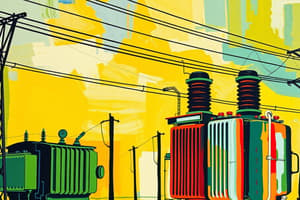Podcast
Questions and Answers
What should be done when establishing an exclusion zone around downed power lines?
What should be done when establishing an exclusion zone around downed power lines?
- No exclusion zone is needed
- Establish an exclusion zone equal to the length of the distance between two poles (correct)
- Establish an exclusion zone equal to half the distance between two poles
- Establish an exclusion zone equal to double the distance between two poles
Why should you exercise caution when raising or lowering ladders near power lines?
Why should you exercise caution when raising or lowering ladders near power lines?
- Because power lines can emit radiation
- Because power lines can be loose
- Because power lines can cause electrical shock
- Because power lines can suddenly move (correct)
What should you do if you encounter a vehicle or apparatus in contact with electrical wires?
What should you do if you encounter a vehicle or apparatus in contact with electrical wires?
- Use a water stream to cool the wires
- Touch the vehicle to check if it's safe
- Do not touch the vehicle or apparatus (correct)
- Try to move the vehicle away from the wires
What type of fences can be energized by wires outside of your field of view?
What type of fences can be energized by wires outside of your field of view?
Why should you avoid using solid or straight water streams on fires in energized electrical equipment?
Why should you avoid using solid or straight water streams on fires in energized electrical equipment?
What should you do if you experience a tingling sensation when near downed power lines?
What should you do if you experience a tingling sensation when near downed power lines?
What is the primary reason for establishing an exclusion zone around downed power lines?
What is the primary reason for establishing an exclusion zone around downed power lines?
Why should you be aware of other wires that may have been weakened and may fall at any time?
Why should you be aware of other wires that may have been weakened and may fall at any time?
What is the primary concern when dealing with damaged electrical lines?
What is the primary concern when dealing with damaged electrical lines?
Why should you exercise caution when working near power lines?
Why should you exercise caution when working near power lines?
Flashcards are hidden until you start studying
Study Notes
Electrical Installations
- Electricity is generated by power plants and stepped up for efficient transmission over long distances to substations near the load centers.
- Transmission lines operate between 69,000 volts and 500,000 volts.
- At substations, voltage is reduced and power is sent through distribution lines to industrial, commercial, and residential customers.
Concepts and Definitions
- Voltage is the difference in electrical potential between two points in an electrical field, measured in volts (V).
- Current is a flow of electrical charge, measured in amperes (A).
- Alternating Current (AC) refers to a current that reverses direction 60 times per second (60 Hz).
- Direct Current (DC) refers to a current flowing only from positive to negative.
- Resistance is similar to the effect of friction on the flow of water in a pipe, measured in ohms (Ω).
Grounding and Bonding
- Grounding is the process of mechanically connecting isolated wires and equipment to the earth, with sufficient capacity to carry the fault current and ensure the wires and equipment remain at the same potential (same voltage) as the earth (ground).
- Bonding is the process of joining together two conductors that do not carry currents, to ensure they are at the same electrical potential.
- Grounding is still required after bonding to protect against electrical shocks.
Electrical Hazards
- Arcing: a sudden release of electrical energy bridging a gap between two conductors, can be extremely hot.
- Overheating: loose connections and overloaded electrical conductors or motors can cause overheating, leading to fires.
- Low Voltage: most electrically caused fires originate in equipment operating below 750 V.
- High Voltage: electricity can arc through the air to a person, tool, or other conductor if they get too close.
Safe Limits of Approach
- The Canadian Electrical Code provides safe limits of approach for rescuers, tools, and equipment to prevent electrical shocks.
- Minimum distances from live power lines vary from 1 M (3 ft) to 6 M (20 ft) depending on the voltage.
Voltage Gradient on the Ground
- Electricity always seeks the path with the least resistance to the ground.
- Conductive grounding rods are used to ensure any stray current is returned to earth safely.
- When a "live" wire lies on the ground, the electricity will fan out from the point of contact, creating a ground gradient.
- The ground gradient creates two problems: step potential and touch potential.
Injuries Caused by Shocks and Electrocutions
- The path electricity takes through the body is critical, and current passing through the heart or brain is more life-threatening.
- Factors affecting the severity of injury include the current, voltage, frequency, and duration of exposure.
- Electricity can cause muscle spasms, respiratory arrest, and cardiac arrest.
Special Considerations for Electrical Emergencies
- Combustible materials can ignite and cause fires in electrical generating plants.
- Faulty electrical equipment can cause arcing or overheating, leading to fires.
- Substations and generating facilities contain transformers, oil, and energized electrical equipment, which can cause fires and release toxic by-products.
- Electrical arc flash hazards can exist when energized electrical conductors or circuit parts are exposed.
Vehicles in Contact with Live Wires
- Emergency responders should not touch any part of the vehicle, as they could be electrocuted.
- Occupants should stay in the vehicle until electrical crews arrive.
- If the operator is injured, they should stay in the vehicle until electrical crews arrive.
Electrical Hazards Encountered by Specific Work Groups
- Welders use electrical systems and must be aware of electrical hazards.
- Crane operators can come into contact with overhead power lines, causing fatalities.
- Haul trucks and other heavy equipment can cause tires to explode if they contact power lines.
- Ground engagement tools (excavators, dozers, graders, etc.) can penetrate energized power lines, causing hazards.
Guidelines for Electrical Emergencies
- Always assume that all electrical wires and equipment are energized until proven otherwise.
- Mine rescue teams must ensure that energy isolation is complete prior to conducting rescue operations.
- Response vehicles should be staged at a distance to avoid exposure to electrical hazards.
- Control the incident scene to eliminate unauthorized access and prevent exposure to electrical hazards.
- Wait for authorized personnel to isolate power before conducting rescue operations.
Studying That Suits You
Use AI to generate personalized quizzes and flashcards to suit your learning preferences.



